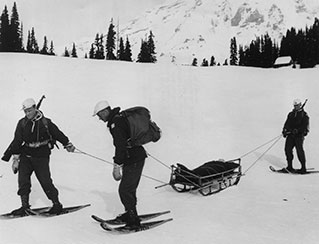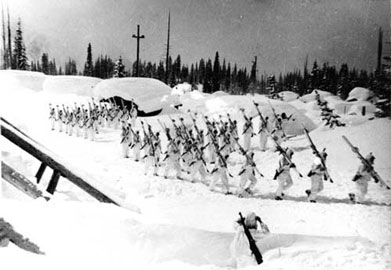Media Included
- 10th Mountain Division at Mount Rainier - This historical footage features the 10th Mountain Division, which trained in the Paradise area of Mount Rainier during World War II. The video clip is an excerpt from Mount Rainier National Park's Human Use Video, which can be viewed at the Henry M. Jackson Memorial Visitor Center in Paradise.
Over the course of World War II, Mount Rainier National Park served as a winter training and testing ground for the U.S. Army’s 10th Mountain Division and other military units. Cold weather testing and training on Mt. Rainier prepared the 'Old 10th' for their legendary march through the mountains of Italy. Driving the Germans out of their mountain strongholds and cutting off their retreat hastened the end of the War in Europe.
Mount Rainier attracted the military for the same basic reason that it attracted natural scientists and tourists: it stood out as an "arctic island in a temperate sea." The vertical zones that made the fauna and flora of Mount Rainier so diverse and beautiful also made the area a good place to find terrain and weather conditions which could simulating conditions in the European Alps and the European winter. Snow and inclement weather were abundant, and if Army officers found the weather at Paradise too mild for their purposes, they only had to march their soldiers higher up the mountain to test cold-weather clothing and equipment under the most severe conditions. Men tested sleeping bags and snow suits on the summit of Mount Rainier. They did sentry duty at night wearing a kind of sleeping bag with legs and feet. One party of ski troops made a circuit around the mountain carrying rifles and 85-pound packs
The Army found Mount Rainier an attractive ground for mountain infantry exercises because of its location near Fort Lewis, too. Established as an Army training camp in World War I, Fort Lewis survived the Army's lean years in the 1920s and 1930s to become one of the major Army installations on the West Coast in World War II. In the 1930s, the commanding officer of Fort Lewis had cooperated with Superintendent Tomlinson of Mount Rainier National Park on the administration of the Civilian Conservation Corps. Still, despite the Army's longtime presence nearby, the use of Mount Rainier for mountain infantry exercises developed fairly suddenly.
On a November day in 1940, a platoon of the 41st Infantry Division, calling itself the Military Ski Patrol, arrived at Paradise for a "preliminary instruction exercise," accompanied by public relations officers and a photographer from the Seattle Post Intelligencer. The four--hour visit heralded a full winter of ski training and maneuvers by a second "Military Ski Patrol"—twenty-four soldiers of the 15th Infantry Regiment, 3rd Infantry Division, also based at Fort Lewis. These soldiers were quartered in government housing at Longmire.
European Winter Wars Inform The U.S. Army

National Park Service
The two military ski patrols from Fort Lewis were of an experimental nature; this was the first time in the history of the U.S. Army that soldiering and skiing were being combined. With the possibility growing that the U.S. Army would be called to fight in central Europe, Army officials began to contemplate the need for specialized mountain units. The idea was given a special impetus by the impressive performance of Finnish ski troops in the Winter War of 1939-40. In that conflict, the greatly outnumbered Finns deployed swift-moving, lightly-armed, ski troops with deadly effect against the ponderous Soviet Army. Photographs of Finnish soldiers on skis gained wide circulation in the American press.
Following exploratory discussions with the presidents of the National Ski Association and the National Ski Patrol during the summer of 1940, the Army initiated military ski exercises with small groups of volunteers at Mount Rainier and at Lake Placid, New York; Old Forge, New York; Camp McCoy, Wisconsin; and Fort Richardson, Alaska. The first regiment of ski troops, the 87th Mountain Infantry, was formed at Fort Lewis the following November. Army units in all parts of the country sent their crack skiers to the new regiment. In December of 1940, Lt. John Woodward, noted skier and mountaineer and formerly captain of the University of Washington ski team, enters active duty with a ski patrol in the 3rd Division’s 15th Regiment, at Fort Lewis, WA. The patrol spends the winter of 1940-41 at Longmire, near Mt. Rainier. At the end of the winter, Woodward leads a patrol that circumnavigates Mt. Rainier. In March he is temporarily assigned to the 41st Division Ski Patrol. There he leads a two-week winter expedition into the Olympic Mountains.
Meanwhile, the War Department entered an agreement with the National Ski Patrol, a civilian organization, to recruit experienced skiers for the special unit. New England ski clubs and Ivy League ski teams provided numerous volunteers. Many European immigrants and exiles joined the 87th Mountain, prompting one writer to call it a virtual foreign legion. The U.S. Forest Service and the NPS contributed more than 20 rangers to the new regiments.
In November of 1941, a platoon from the 41st Division Military Ski Patrol came to Mt. Rainier for a preliminary instruction exercise.’ The following month a detachment from the 15th Infantry (the ‘Can-do Regiment Ski patrol) arrived to spend most of the winter of 1941-42 training in skiing and maneuvers. The high point of their training was a 55 mile, 6 day ski trip.
Training Begins and Evolves

National Park Service
The thousand-man regiment wintered at Fort Lewis during the winter of 1941-42 and sent contingents to train at Paradise under a cooperative agreement with the NPS. In a noteworthy compromise, ski troops claimed full use of the rope tow above Paradise Inn on week-days and yielded the ground to park visitors on weekends. The Army rented and occupied the Paradise Lodge and Tatoosh Club facilities. The Mountain Battalion’s experiences there inspire new verses for an old western ballad quickly adopted by the ski troops. In the song, trooper Sven’s heavy weapons company trains on snowshoes and thus spends “two months in Paradise and never learned to ski,” while “the Winter Warfare Board waited anxiously about.” (Actually, the Board was busy testing new winter rations, clothing, equipment, and over-snow transportation.)
In the spring of 1942, the 87th Mountain transferred to the Army's new Camp Hale, located on the Continental Divide in Colorado, where it formed part of the 10th Mountain Infantry Division. In May, an expedition climbs to the summit of Mt. Rainier, an event filmed by Lt. John C. Jay, who has already produced ski-training films for the U.S. Army. After the war, Jay will become a legendary maker of ski films. More Army units were dispatched to Mount Rainier for special training in the fall of 1943.
Over the course of World War II, training would be expanded to included a 100-man detachment of ski troops from the 10th Mountain Infantry Division, a 150-man force from the 938th Aviation Engineers who undertook snow camouflage tests, and a 30-man unit of photographers from the Army Signal Corps who made an army training film. Cold weather units testing long skis over short, soft boots over hard, tight boots versus loose boots, winter food rations, and many different types of fabric for livable tents in below-zero temperatures.
National Park Service Rangers provided unique support to the training units by leading classes on mountaineering, search and rescue, meteorology, glaciers, avalanches, forest fires and geology.
The Legacy of 10th Mountain Division
These units pulled out by the end of November 1943, ending Mount Rainier's role in World War II as a training and testing ground.The 10th Mountain Division was the only unit of kind in the US. Later in the war was involved in retaking the Aleutian Island of Kiska from the occupying Japanese Army, a site currently preserved by WWII Valor in the Pacific National Historic Park.
At the beginning of 1945, the 10th Mountain left ports in Virginia to deploy to the front lines in the mountains of Italy. In cooperation with allied units, the 10th Mountain sustained heavy fighting as they dislodged the germans from artillery positions throughout the Apennines, clearing some of the mountains highest peaks to allow for allied forces to advance. Succeeding where other divisions had failed, the 86th Mountain Infantry assaulted Riva Ridge through a 1,500 vertical assent nighttime attack. Considered unscalable by the Germans, the February, 1945 attack succeeded.
The 85th and 87th regiments assaulting the heavily manned and mined German stronghold of Mt. Belvedere next. Surprising the Germans again with a bayonet attack without covering artillery fire, the peak was captured. Seven german counterattacks followed over the next three days costing the 10th Mountain Division 850 casulaties. But the Division held the mountain.
Final advances into the Po Valley cost the Division dearly, but broke the German lines. By April, the 87th Mountain Infantry crossed the Po River under heavy fire in 50 light canvas assault boats. At the foothills of the Alps within days, the Division cut the German Army’s main escape routes through the Brenner Pass, hastening surrender and the end of German resistance in the area. In 114 days of combat, the 10th Mountain Division had decimated five elite German divisions, suffered 992 killed in action and 4,154 wounded.
Many of the men in the 10th Mountain Division came back to become legendary, world class climbers of their day. The 10th Mountain Division association membership book shows names of several former Mt. Rainier rangers and summit guides. Former rangers who served in the 10th include: Larry Jensen, Elvin R “Bob”/”Swede” Johnson, Cornelius M “K” Molnaar, Gordon K “Pat” Patterson, George R. Senner and Dar Williams.
A bronze memorial dedicated to the valor and bravery of the 10th Mountain Division is located in the Paradise Lodge area of Mt. Rainier National Park.
Last updated: November 4, 2019
